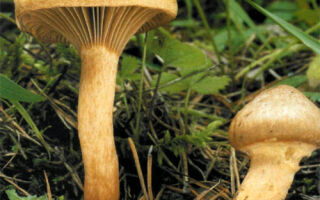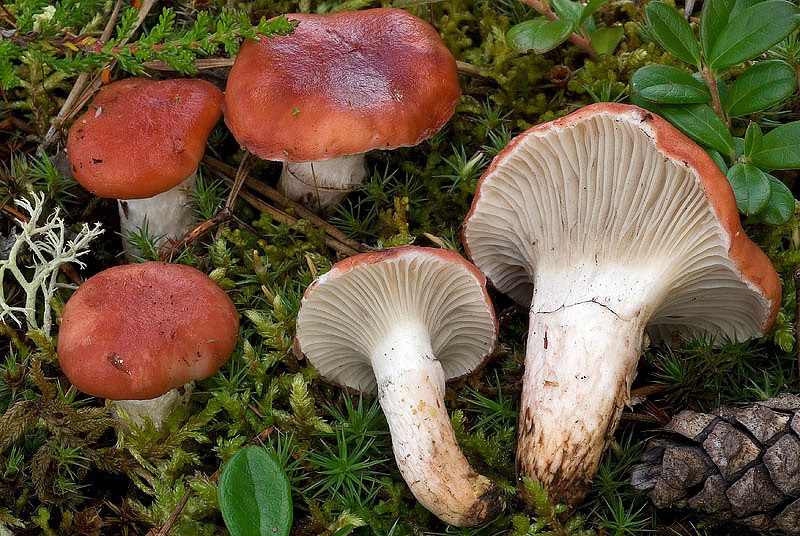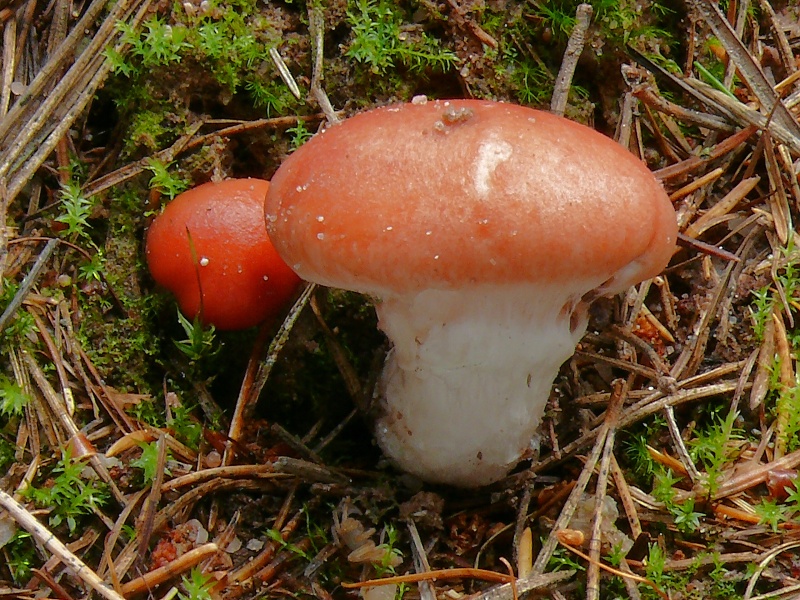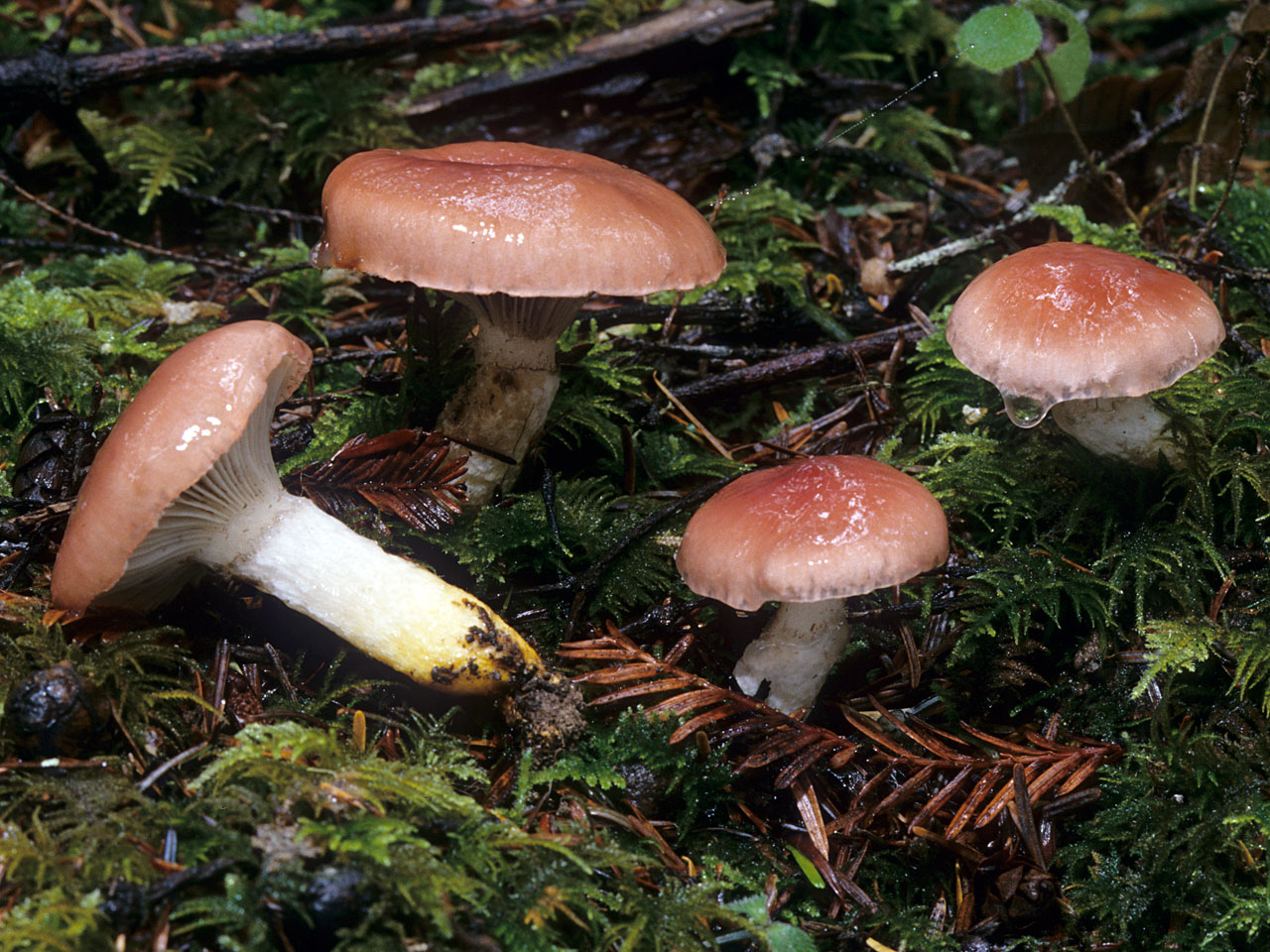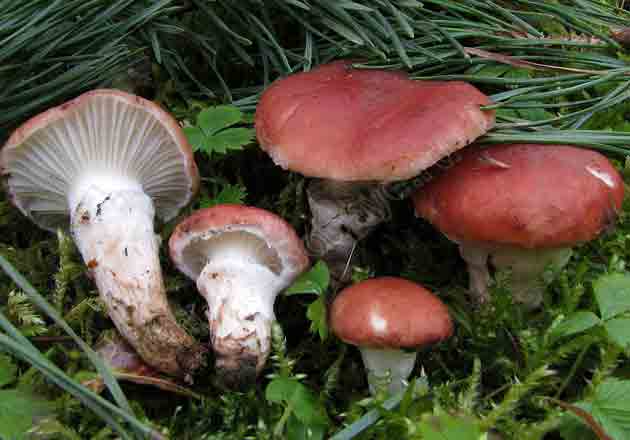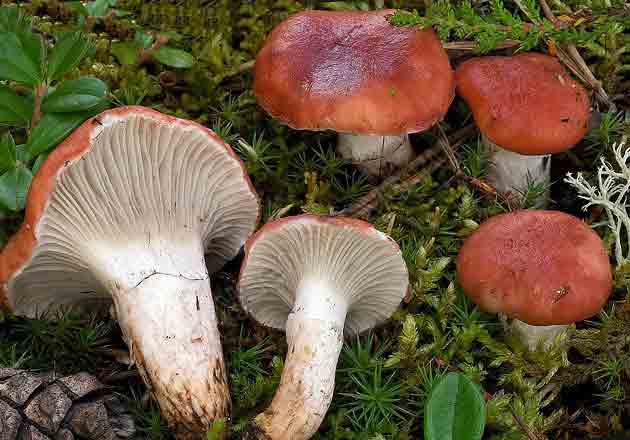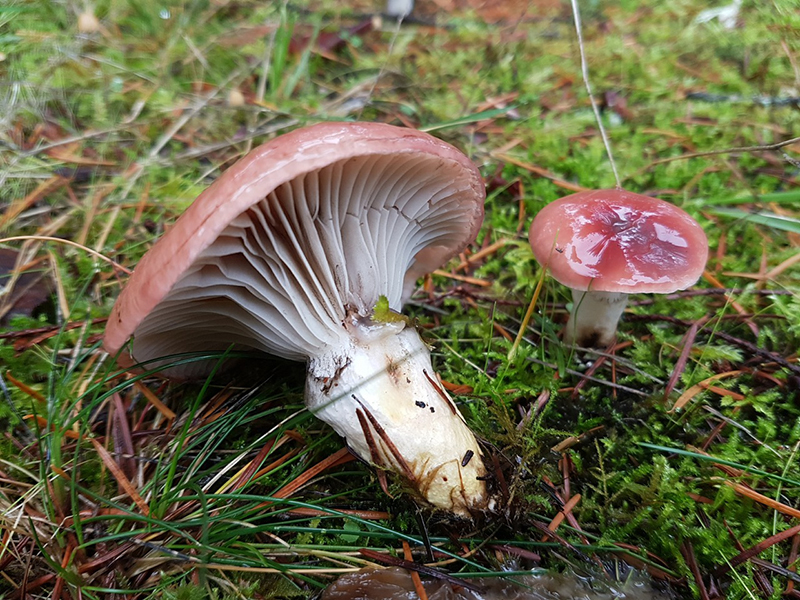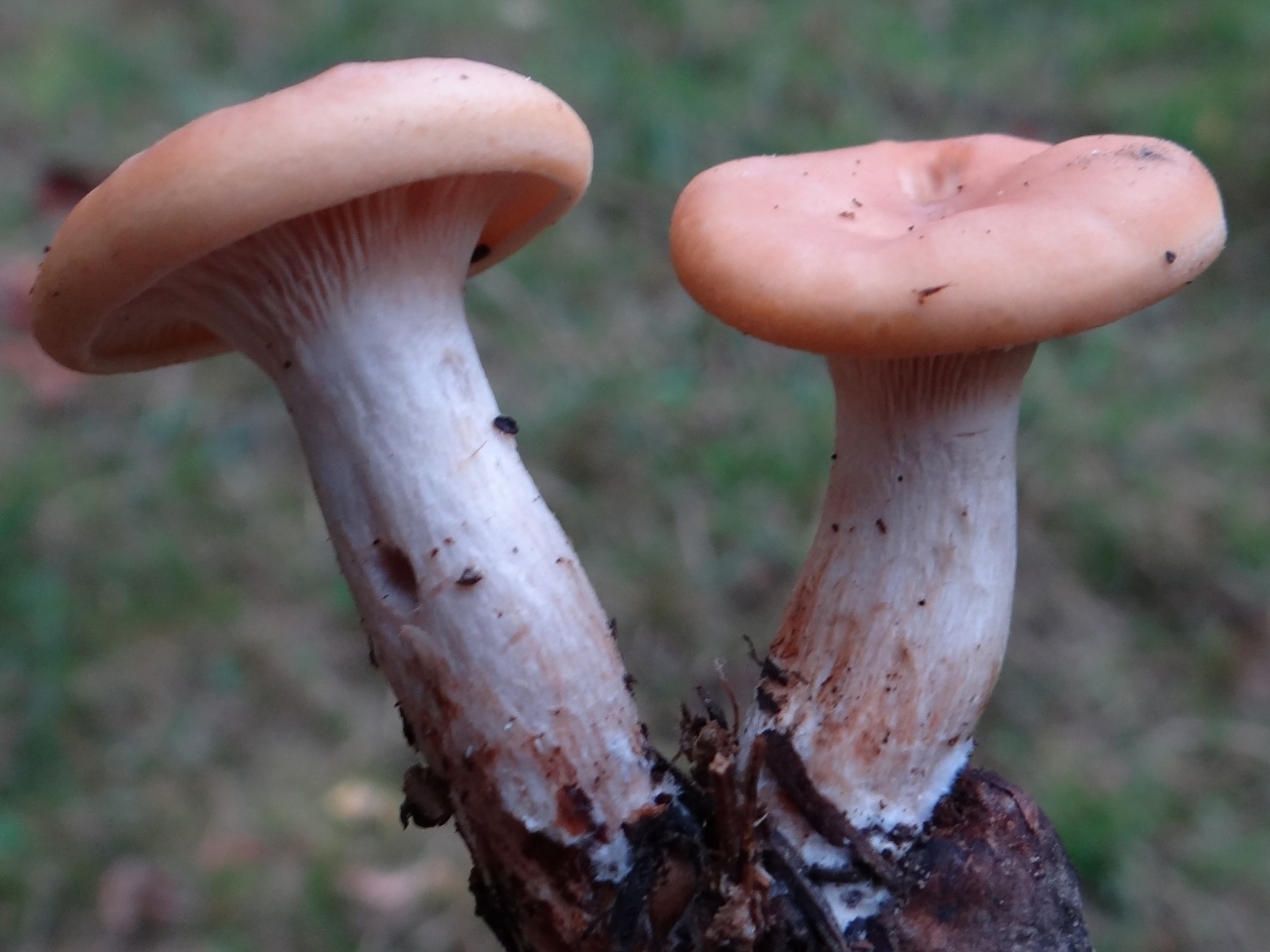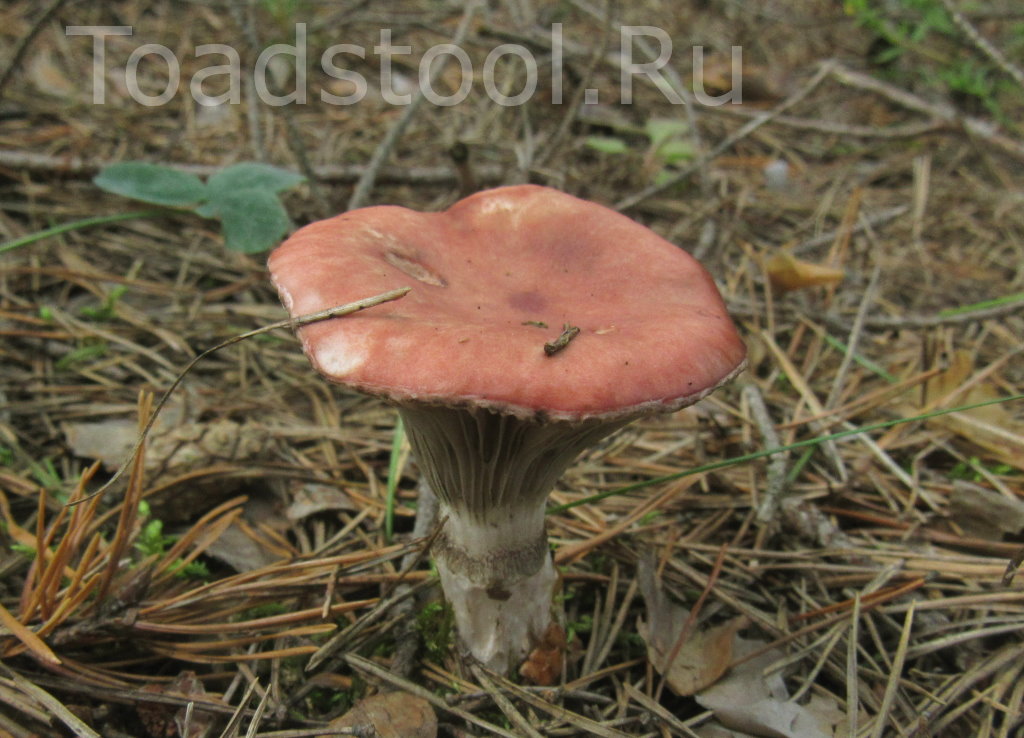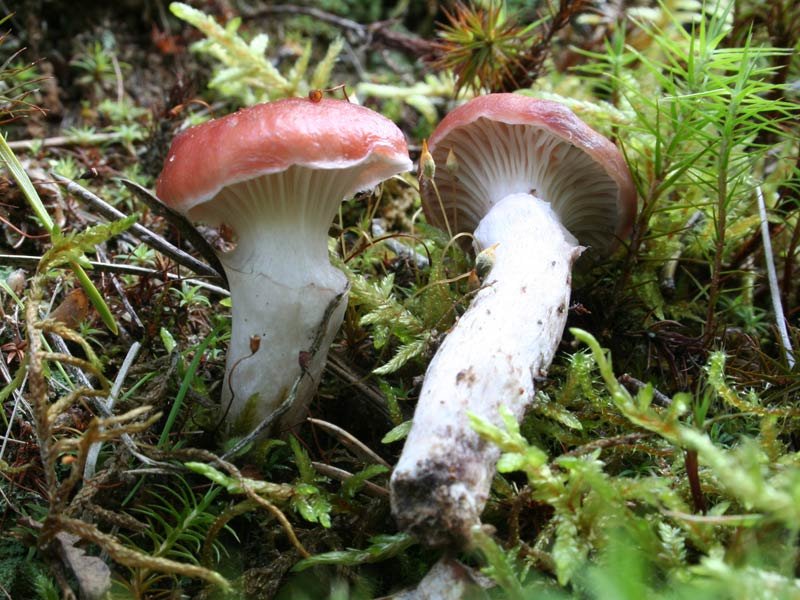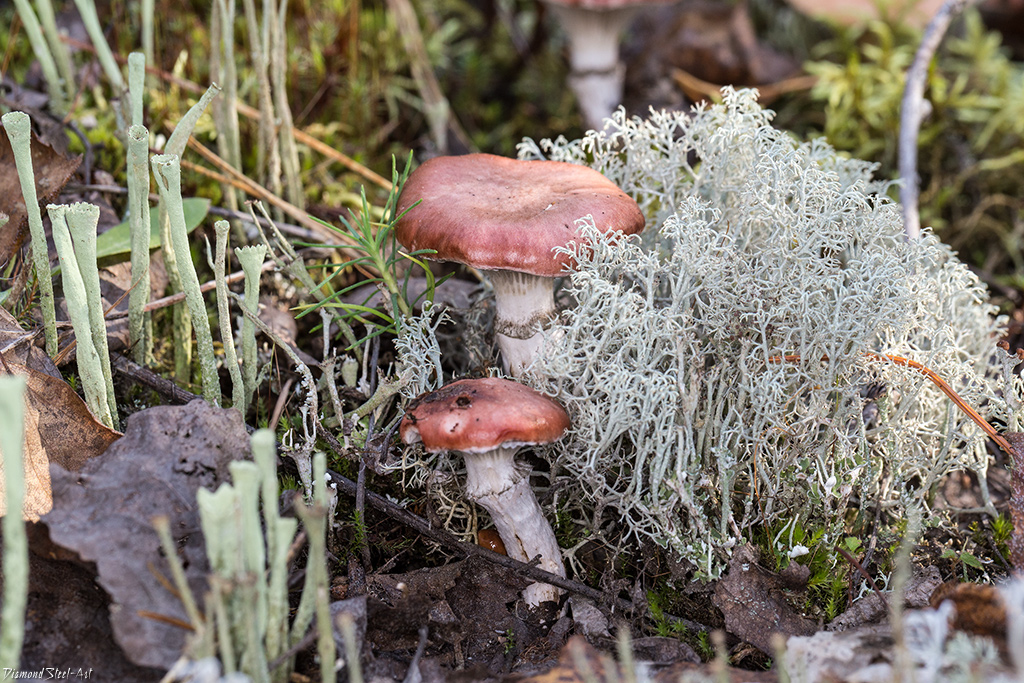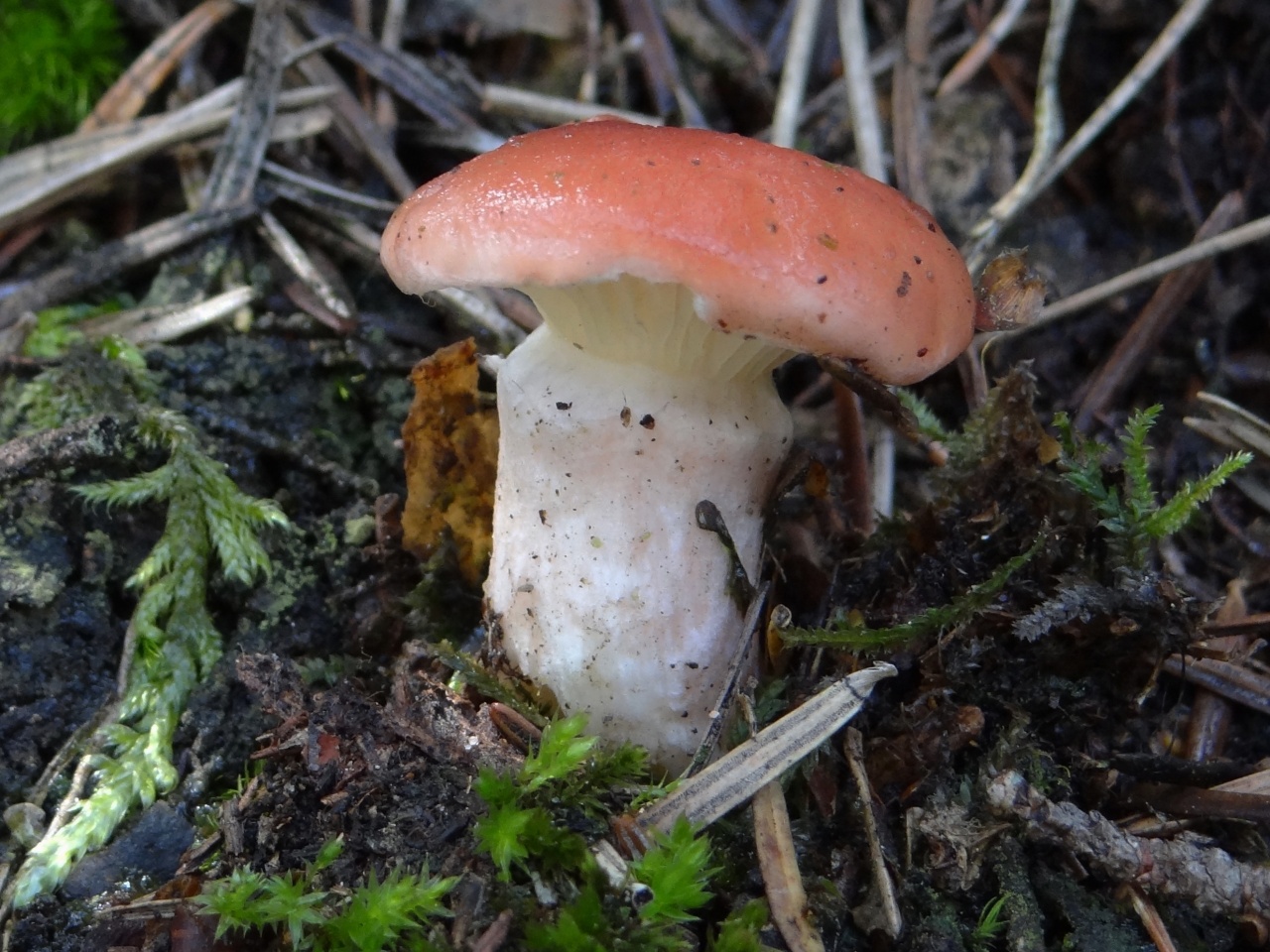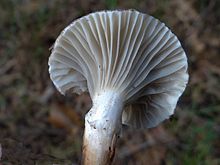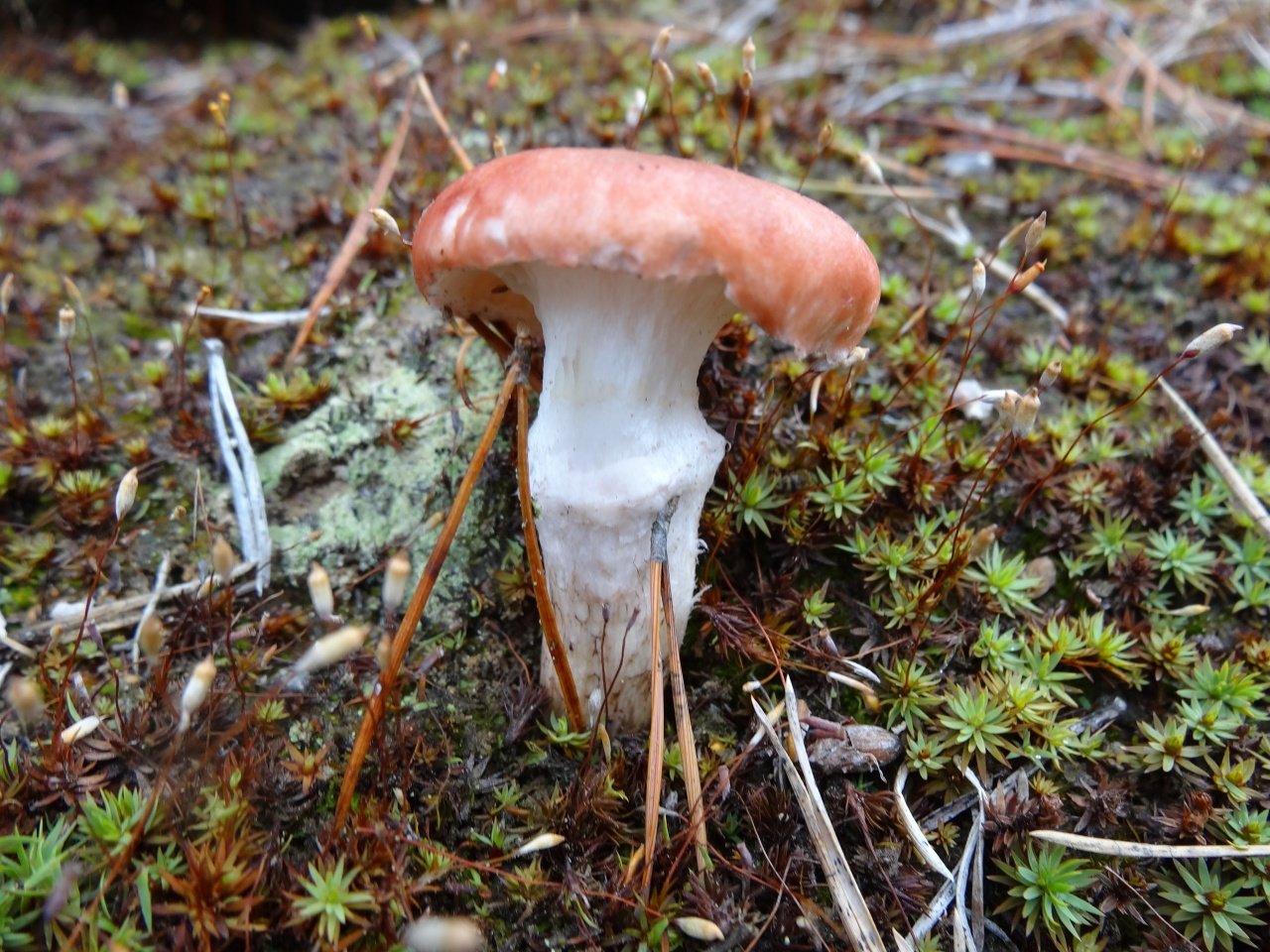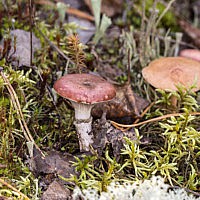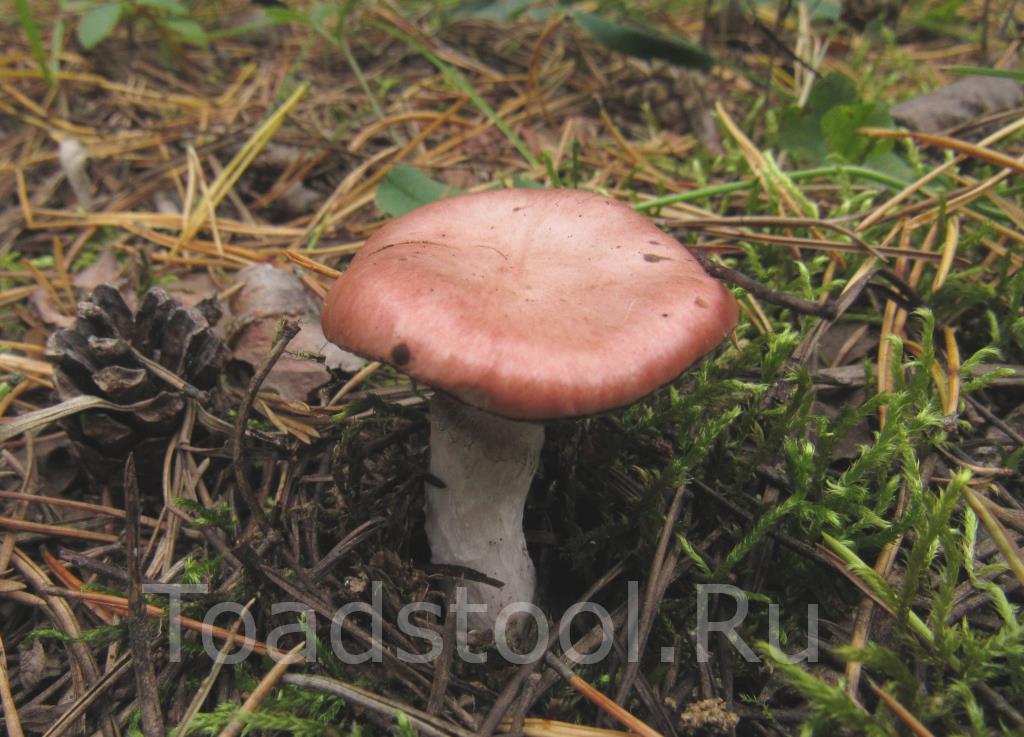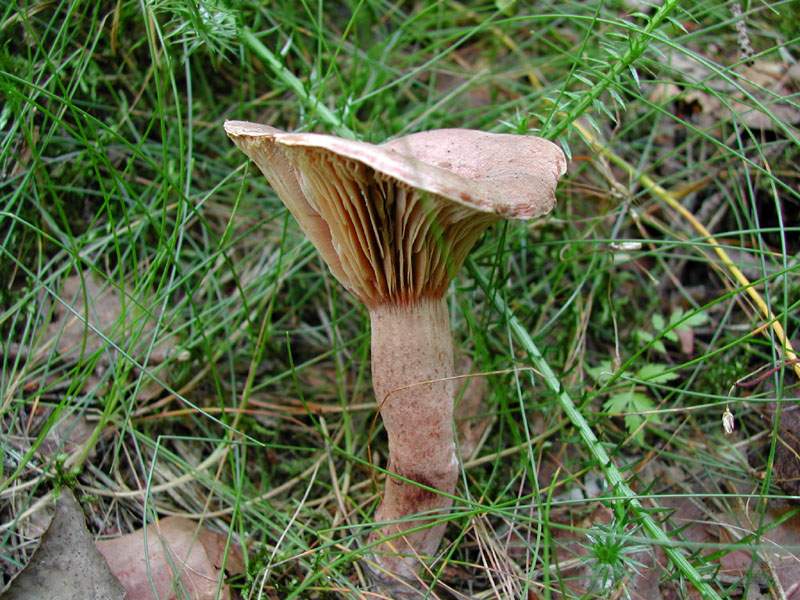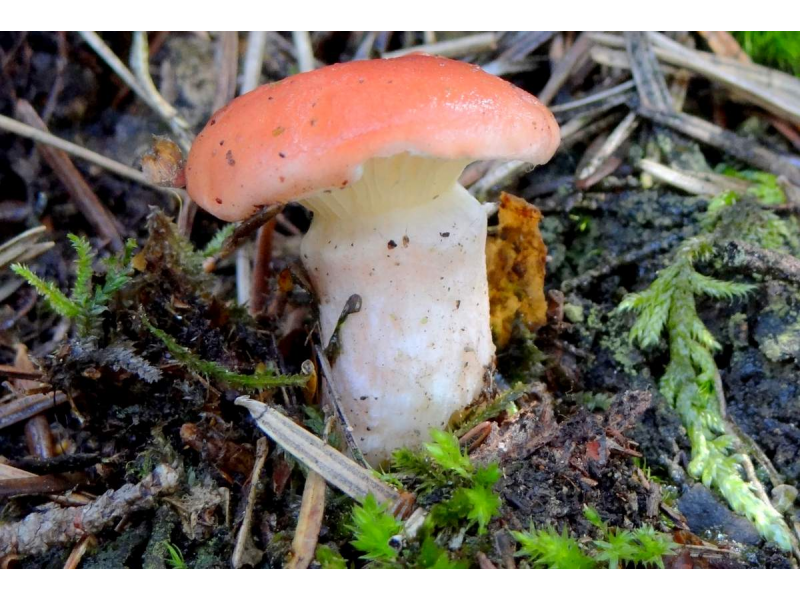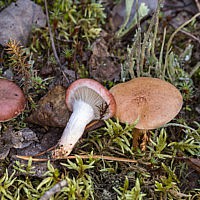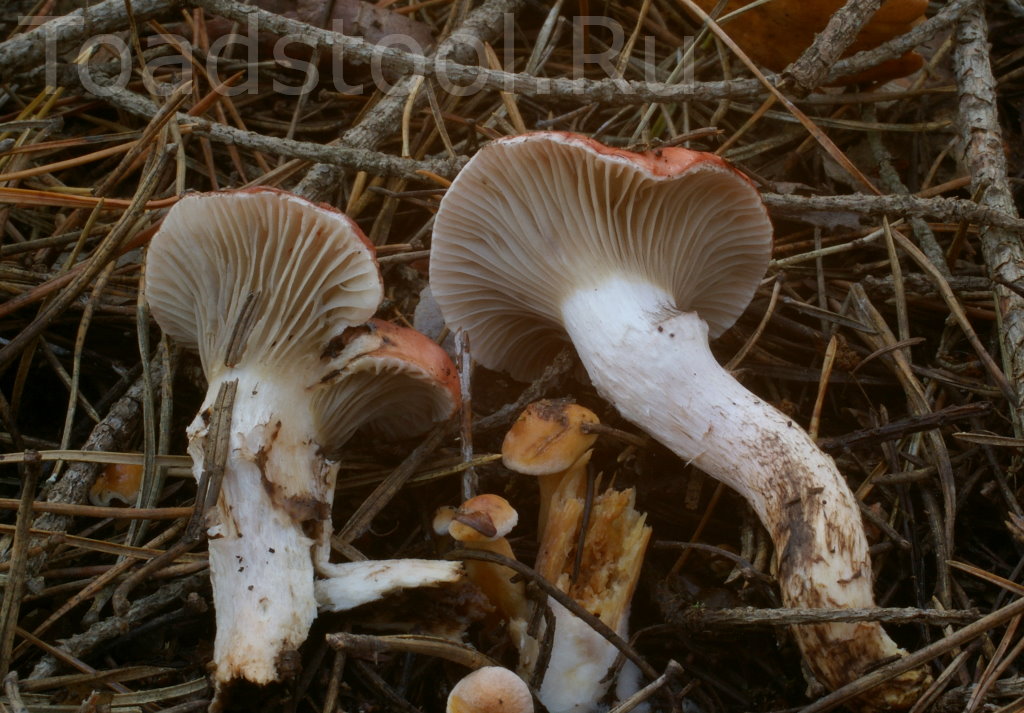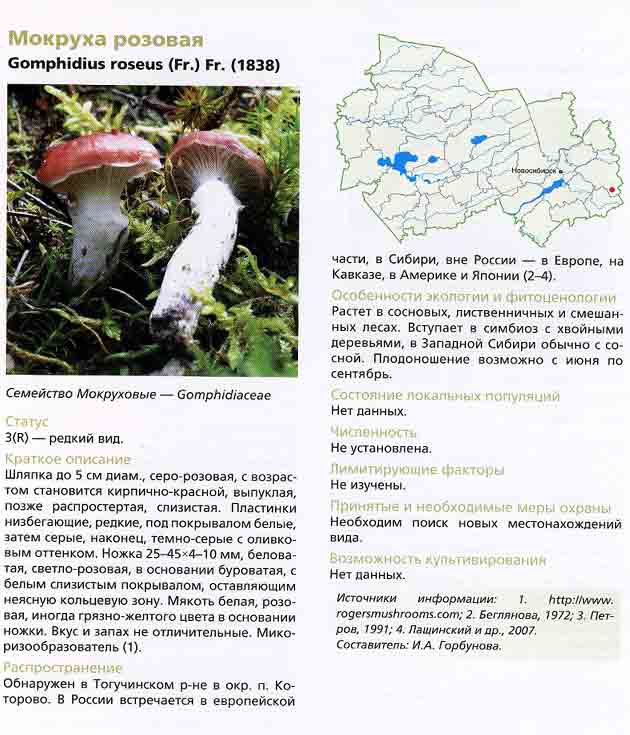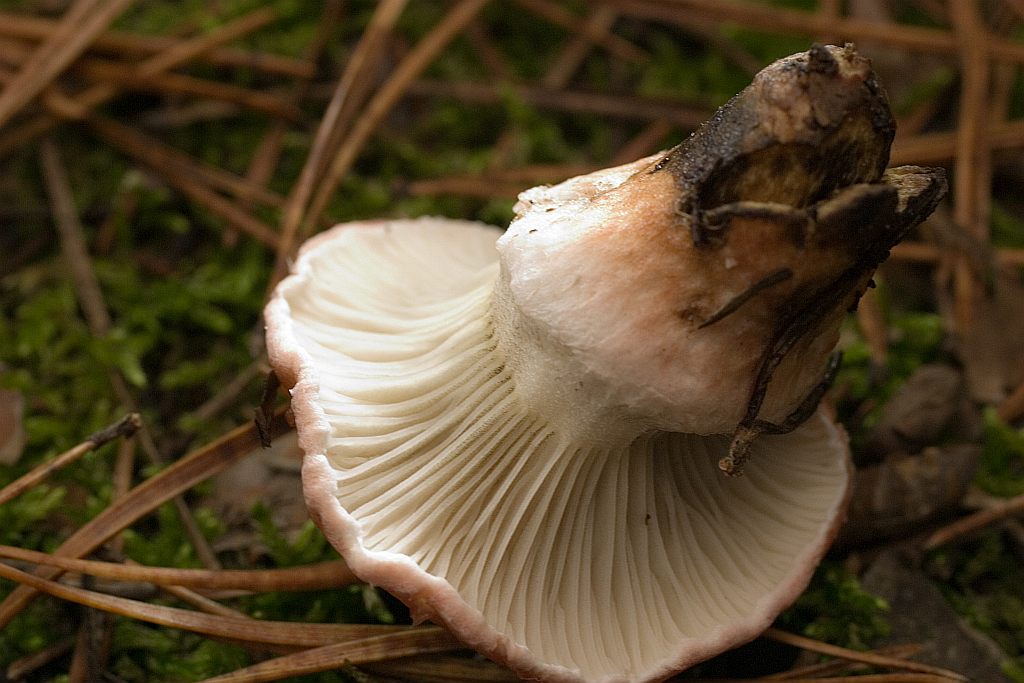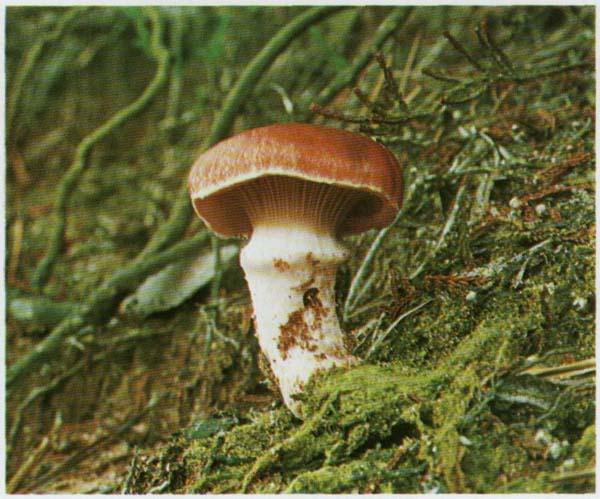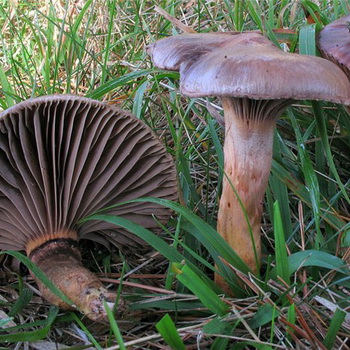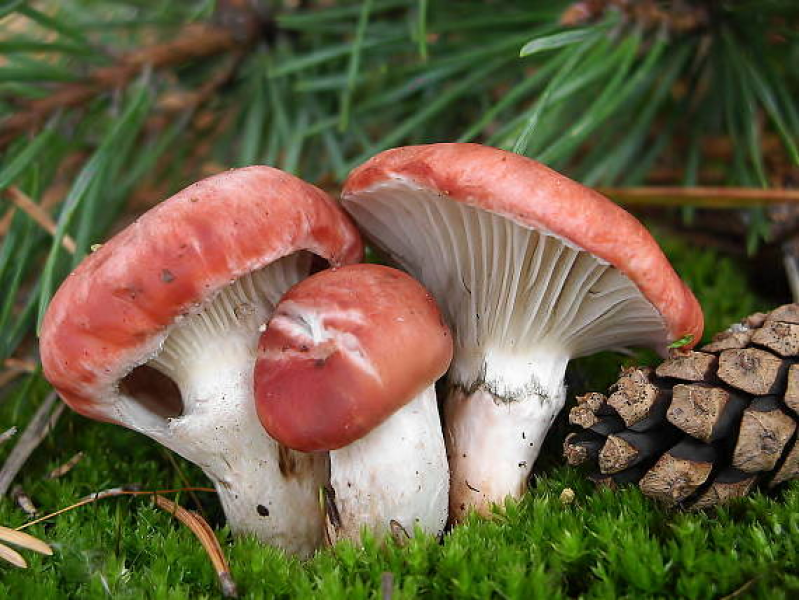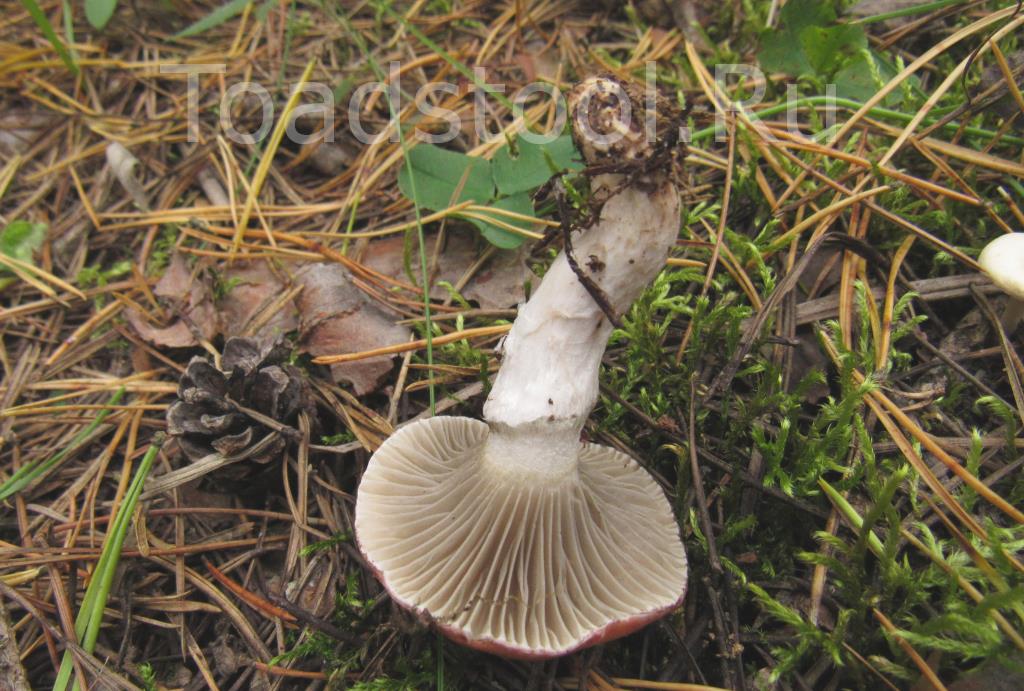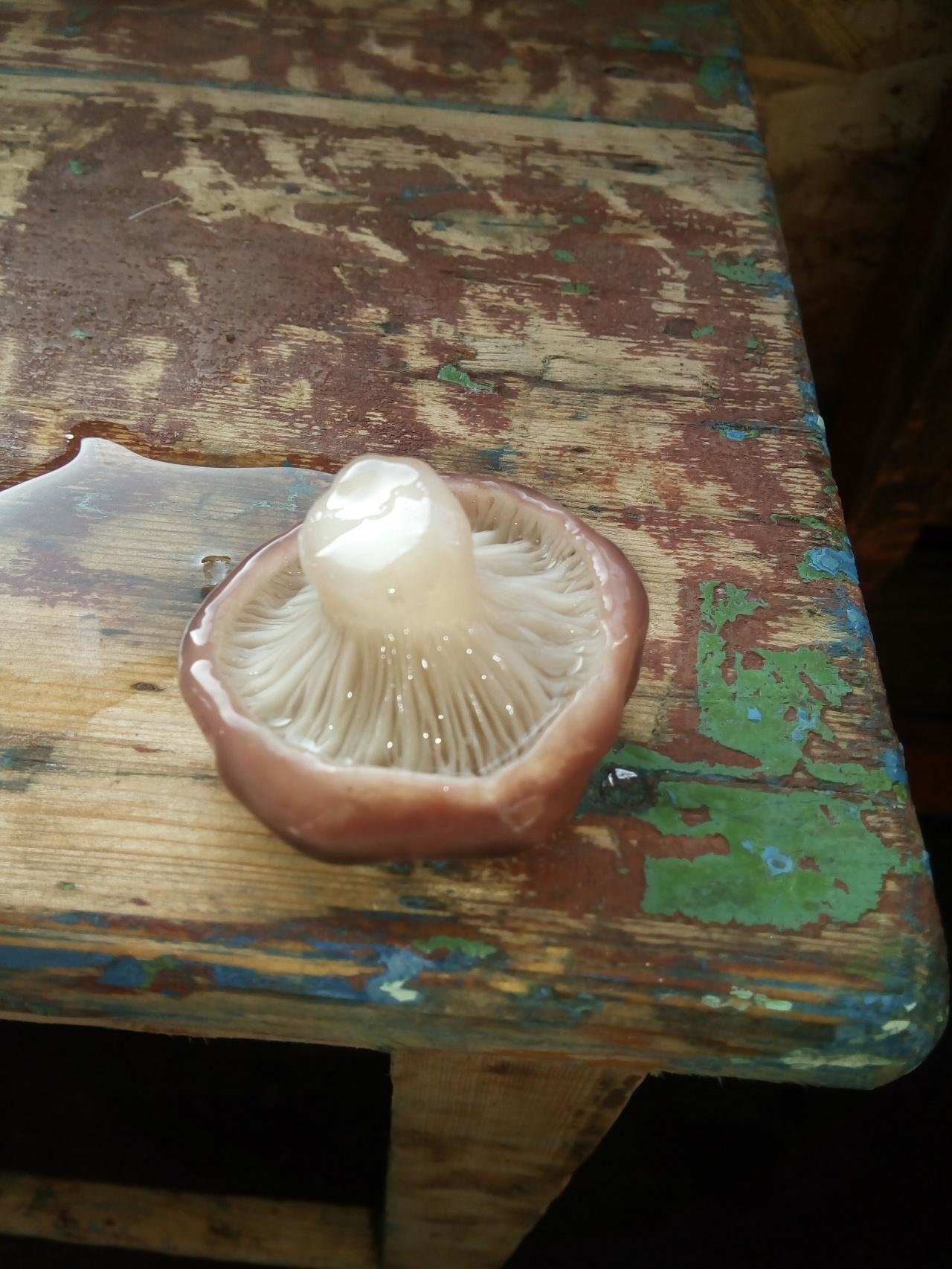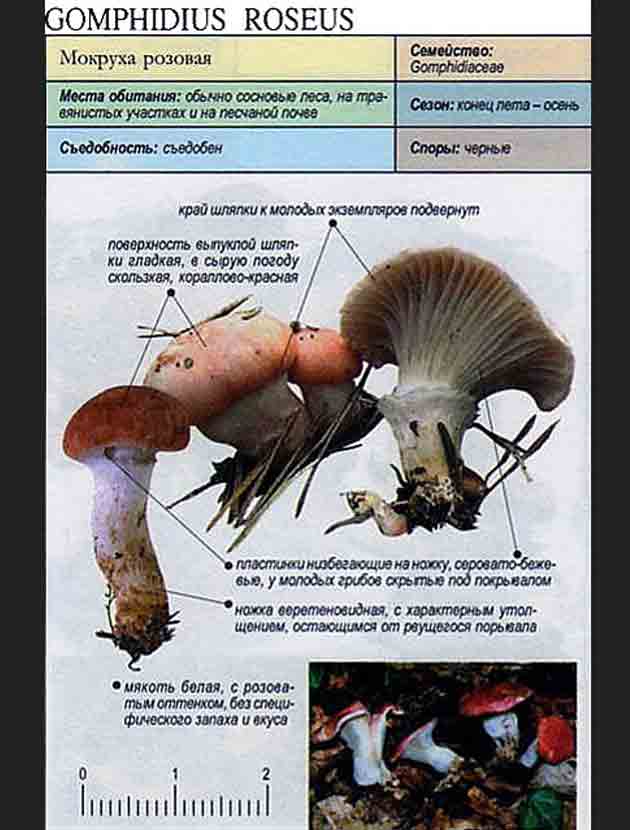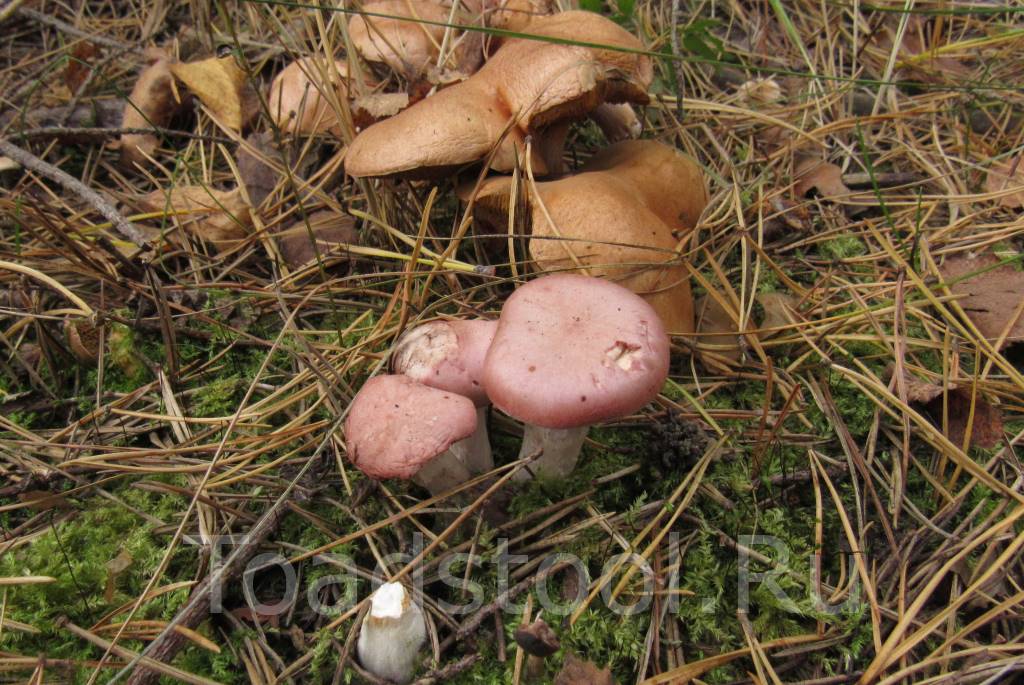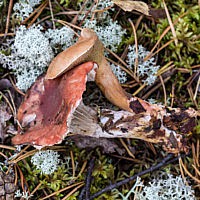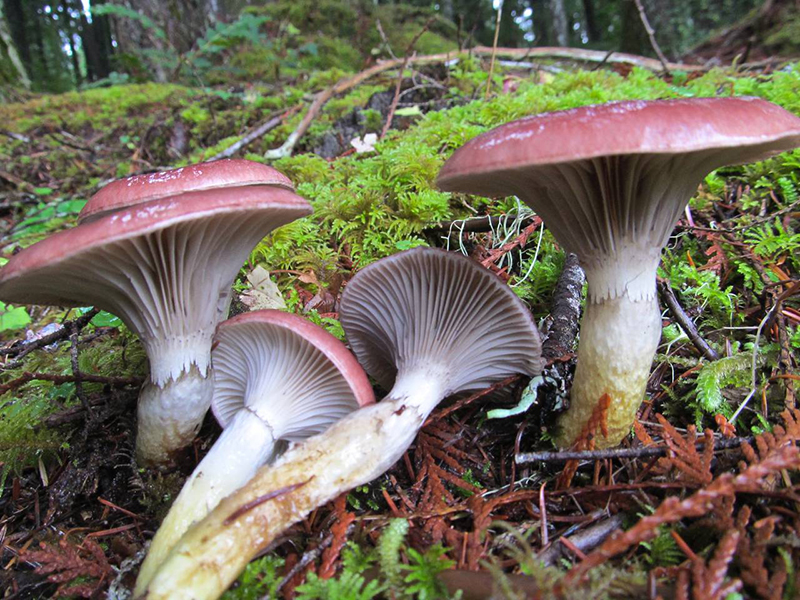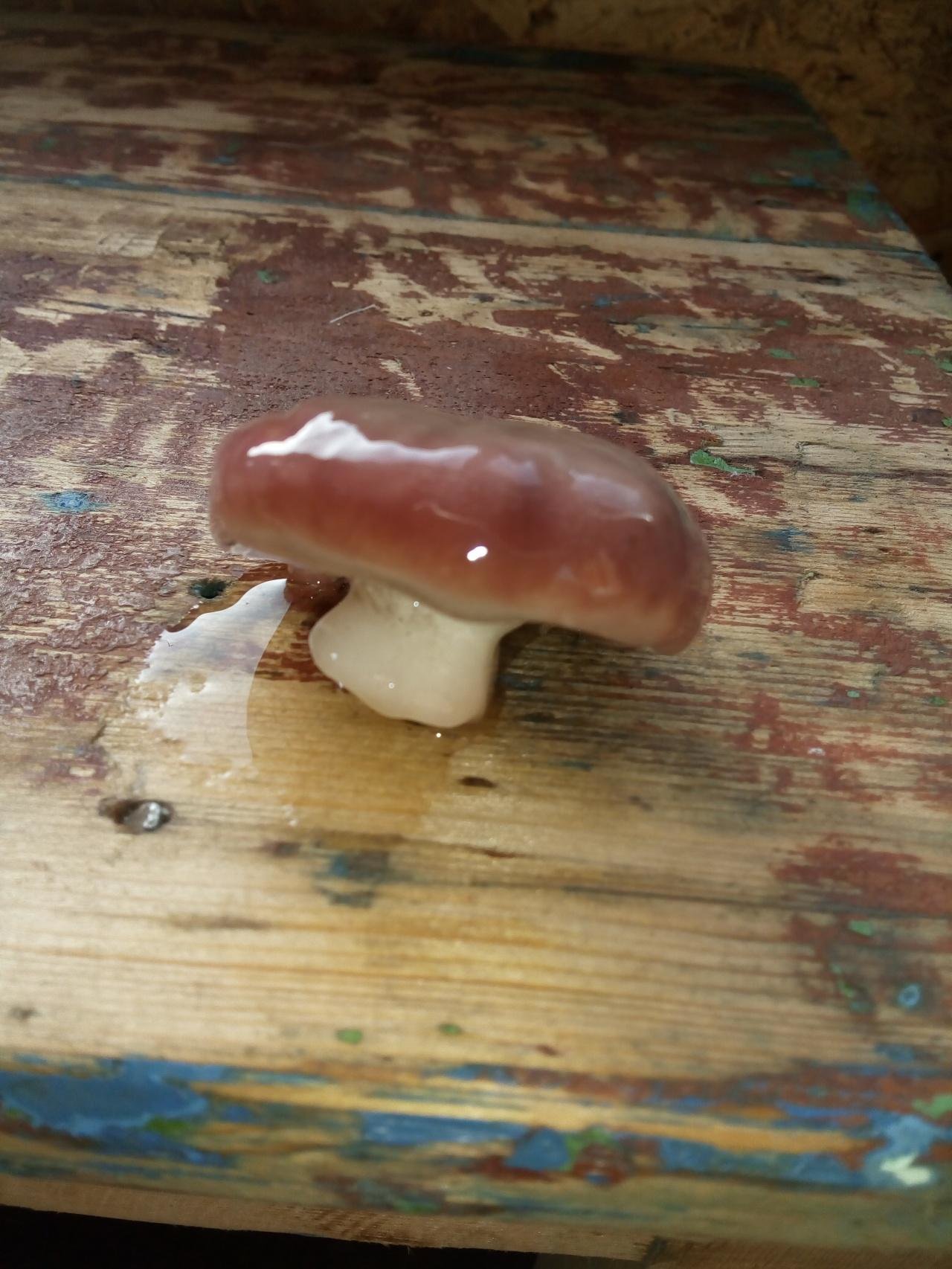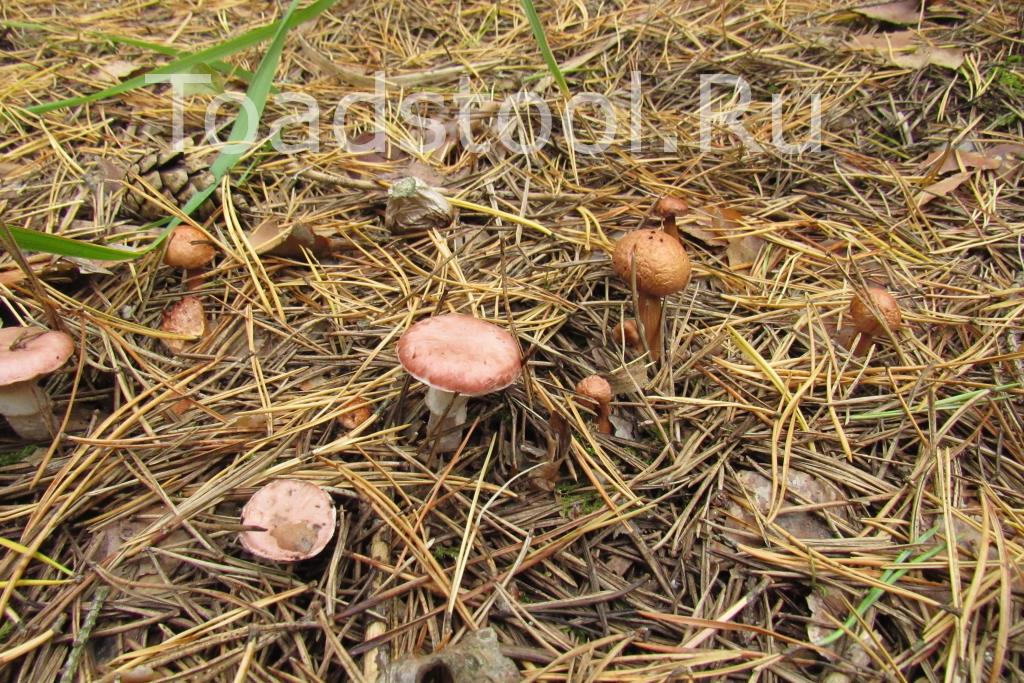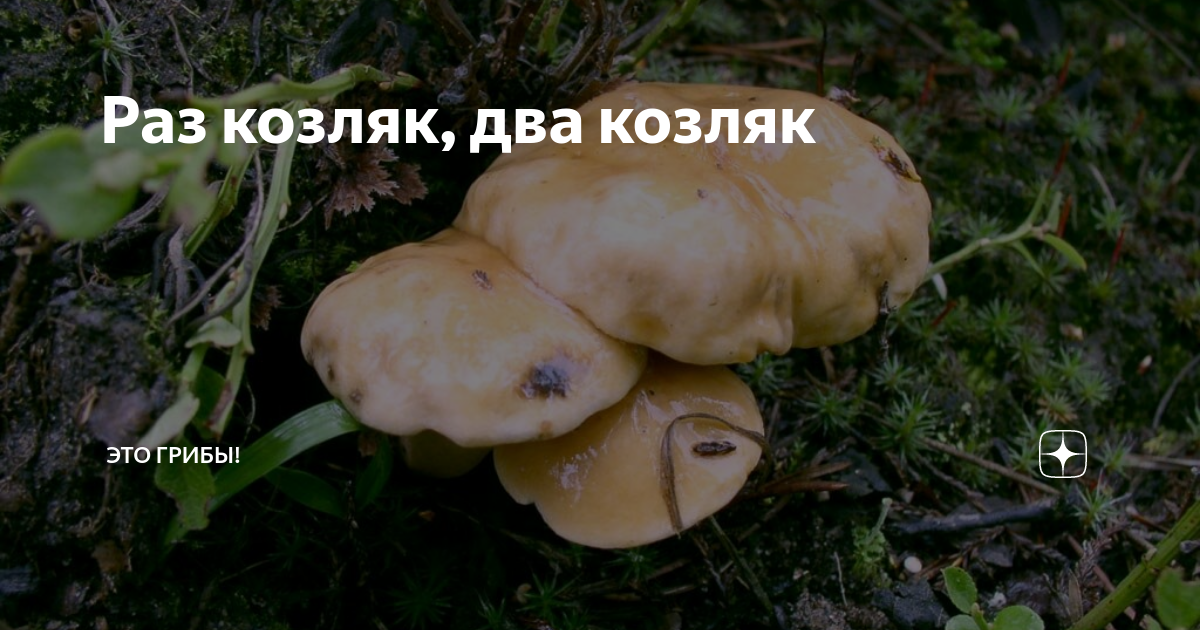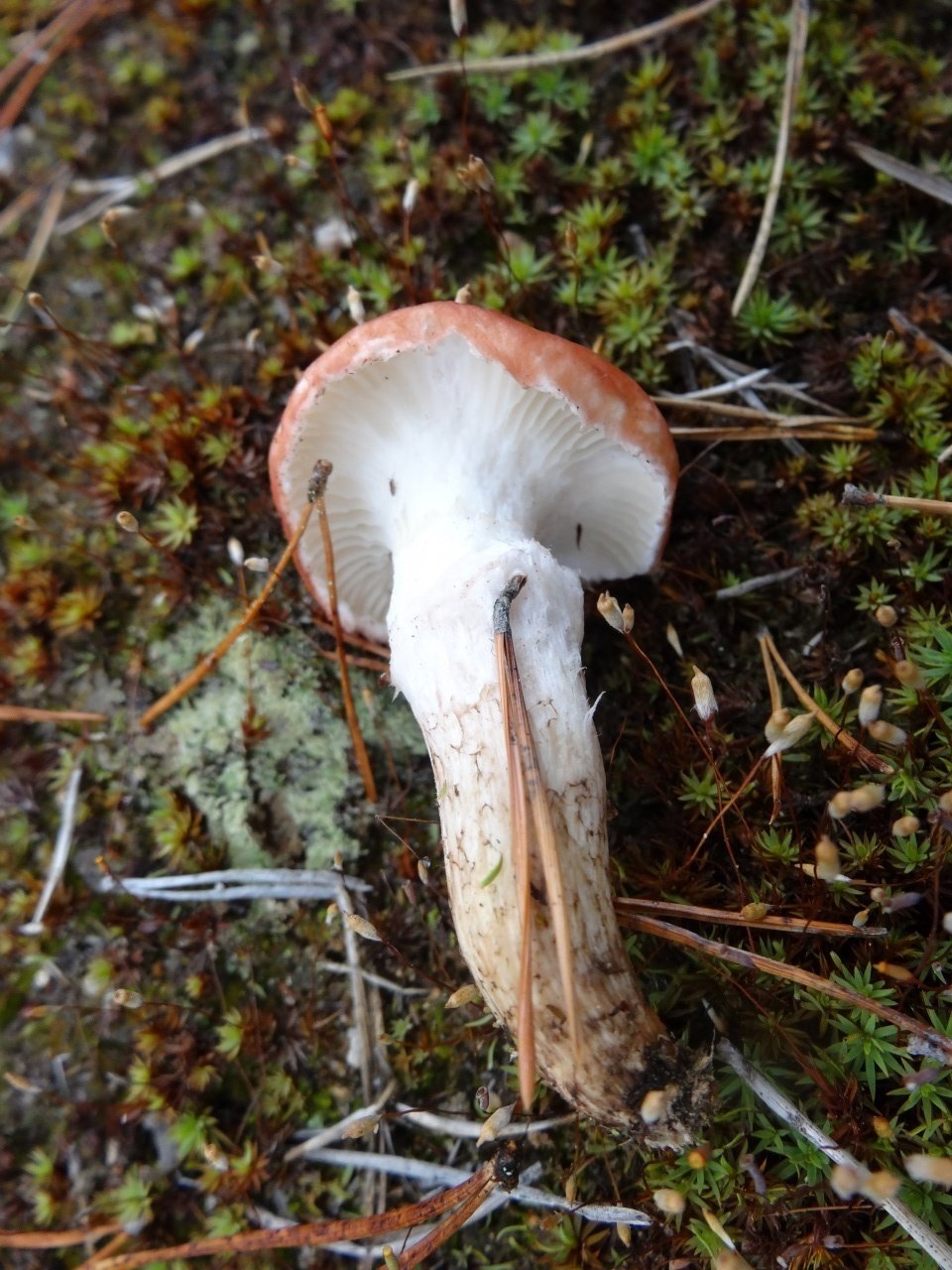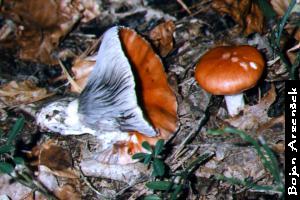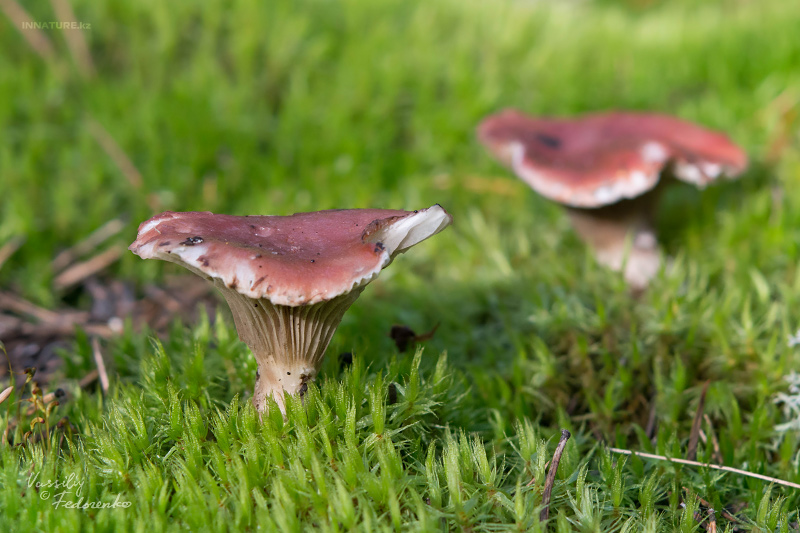Yellow-legged peat (Chroogomphus rutilus)
- Other names for the mushroom:
- Mokruha purple
- Pine Mokruha
- Mucous mucosa
- Mokruha is shiny
- Mokruha purple
Other names:
- Gomphidius viscidus
- Gomphidius rutilus
Chroogomphus rutilus (lat.Chroogomphus rutilus) is an edible mushroom of the Mocrucidae family.
External description
Hat:
The diameter of the purple cap is 4-8 cm, at a young age it is neat, rounded with a blunt tubercle, with age it opens to a prostrate and even funnel-shaped. Color - peculiar, brown-lilac, with a wine-red tint; in young specimens, the central part is colored in purple tones; with age, the color becomes more uniform. The surface is smooth, very slimy when young, especially in wet weather. The pulp is thick, lilac-pinkish, without any special smell or taste.
Plates:
Wide, reaching to the leg, in youth mauve, with age they acquire a dirty brown, almost black color. In young specimens, the plates are covered with a mucous private veil of lilac-brown color.
Spore powder:
Dark brown, almost black.
Leg:
The height of the stem of the purple moss is 5-10 cm, the thickness is 0.5-1.5 cm, it is often curved, usually slightly narrowed at the base. The color is the same as that of the cap, but somewhat lighter; the surface of the leg is silky, with ring-shaped remnants of a private veil, which become hardly noticeable at maturity. The pulp is fibrous, lilac-red, bright yellow at the base.
Spreading
The yellow-footed phlegm grows from the beginning of August to the end of September in pine forests and in forests with an admixture of pine. In addition to pine, Chroogomphus rutilus forms mycorrhiza with cedar and birch. Occurs in small groups, relatively infrequently.
Similar species
At a respectable age, as well as in wet weather, all mokruhs are similar to each other. Spruce peel (Gomphidius glutinosus) cooperates, respectively, with spruce, and is distinguished by the bluish color of the cap. Pink bough (Gomphidius roseus) can be easily distinguished from Chroogomphus rutilus by its bright pink cap and lighter blades.
Remarks
It's funny to see how the perception of the fungus changes depending on where it actually grows. Spruce moss in a gloomy bearded spruce forest - a gray-gray monster, swollen with mucus and boasting of its own uselessness; a light dry pine forest, which has grown purple moss on its litter, paints this mushroom in elegant and slightly frivolous tones. Here it is very easy to believe that mokrukhs are close relatives of boletus; and even mucus, it seems, is no longer mucus, but simply "butter". However, you still don't want to collect them: alien, completely alien mushrooms, alien and not similar to anything tasty.
Mokruha purple and a photo of a mushroom
Category: edible.
The name of the purple moss (Chroogomphus rutilus) literally translates from Latin as "yellow-red", "golden-red". The color of this mokruha is not always purple. And the specific name appeared due to the fact that when exposed to high temperatures, the mushroom becomes exactly purple.
Hat (diameter 4-14 cm): shiny red-brown, brick-red or lilac; in old mushrooms, it usually fades strongly and loses its variegated color. Initially conical, with a central tubercle, over time becomes convex or almost prostrate. Has a brown cover, in a dark and damp place or after rain can be covered with a layer of sticky mucus. The edges are usually curved towards the inside.
Leg (height 4-10 cm): solid and curved, in the shape of a cylinder. Usually the same color as the cap, a little sticky.

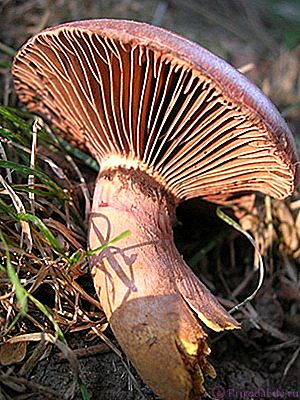
If you carefully look at the photo of the purple moss mushroom, you will notice that its arcuate plates are easily separated from the cap. Most often they are purple or purple.In old mushrooms, they become almost black.
Flesh: fleshy, fibrous in the lower part. A yellowish color at the site of the fracture and upon interaction with air changes to pink or red. Has no pronounced smell and taste.
Insect pests are especially fond of purple moss, so it is worth carefully examining the mushroom before putting it in the basket.
Doubles: five edible moss, namely felt (Chroogomphus tomentosus), spruce (Gomphidius glutinosus), Swiss (Chroogomphus helveticus), pink (Gomphidius roseus) and spotted (Gomphidius maculatus). The difference is that the felt cap has a whitish pubescence; spruce, as a rule, grows only next to spruce, and also has a more grayish-gray color; the Swiss cap is ocher and also with a slight felt pubescence. The pink moss has light plates and a bright pink cap, and the spotted one almost always grows under the larch trees.
When it grows: from early August to late September in temperate countries of the Eurasian continent. In Russia, mainly in European territory, less often in Siberia and the North Caucasus.
Where can you find it: on calcareous soils of coniferous and deciduous forests, most often next to pine and birch.
Eating: in any form, provided that the mucous skin is removed from the cap.
Application in traditional medicine: not applicable.
Other names: mucous moss, shiny moss, yellow-legged moss, copper-red yellow legged.
Growing at home and in the country
In order to plant purple moss on your site, you should purchase a mycelium, which is mixed with a small amount of soil. You need to plant next to a pine tree. An annular hole is dug around the tree up to 10 cm deep, and then the prepared mixture is evenly distributed over the hole.
The purchased package is enough for 1 sq. m. From above, everyone is covered with earth mixed with manure in equal proportions, and then covered with needles. Watering is carried out once a week. In this case, the crop can be harvested up to 4 times a year, and the first mushrooms can be harvested in 2 months. With weak growth, it is worth adding more humus in a proportion of 10 kg per 1 sq. m.
Description of the mushroom
The spruce mud has the Latin name Gomphidius glutinosus, it is also called the Mokruha glutinous, slug mushroom. Belongs to the genus Gomphidius (Mokrukha), the family Gomphidiaceae (Gomphidia or Mokrukh).
It is a fairly rare conditionally edible lamellar mushroom, belongs to the fourth category.
Hat
It is characterized by an unusual gray-violet or gray-blue color with variations in brown. The cap is first convex, then with the age of the fungus it straightens, depressed towards the center, with the edges down. Its diameter is from 5 to 12 cm. The hat is dense, fleshy, covered with a thick layer of mucus (which was the reason for the name of the mushroom).
Hymenophore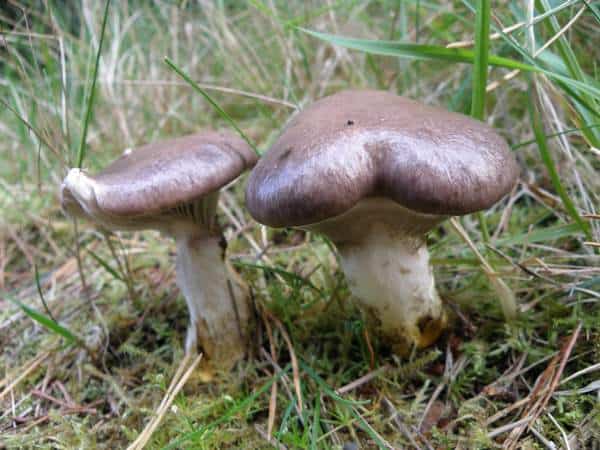
The plates are branched and sparse. Young specimens have white, mucus-covered plates, while older specimens turn black. As it grows, the mucous cover breaks off and envelops only the leg.
Cut pulp
If you break the cap, you can find pink flesh that does not change its color. The taste is soft sweet, the smell is pleasant.
Leg
This part can reach 12 cm in length, rather massive (up to 2.5 cm thick). With age, the fungus becomes denser at the base, changes its color to bright yellow. The surface of the leg is slimy, the spore powder is almost black.
A bit of history
The spruce moss mushroom was originally described by the German mycologist Jacob Schaeffer in 1774. Elias Magnus Fries gave it the binomial name (genus and species) in 1838. The name of the genus comes from the Greek language and is translated as "big nail", and the species is "sticky", which together form a very eloquent name of the mushroom. In Germany it is also called "cow's snout".
Mokruha is spotty, pink and sticky
Mokruha spotted is a high-yielding edible lamellar mushroom that grows in small groups from the second half of July to early October. It is most often found in coniferous, especially spruce and mixed forests, where it selects areas of soil overgrown with a thick layer of moss, and rare thickets of shrubs.
The cap of the mushroom is initially convex, but in the process of growth it flattens a little, and its edges are bent down. The diameter of the cap is about 5 cm.The surface is smooth, moist, wrapped in a thin but dense mucous blanket. It is painted gray with a lilac-yellow tint, on which black spots are clearly visible. Spore-bearing plates are wide, thick, dark gray in color. The leg is rounded, straight, about 7 cm high and no more than 1 cm in diameter. Its surface is smooth, slimy, grayish at the cap, yellow at the base, completely covered with dark spots. The peduncle has a characteristic mucous ring in the center. The pulp is thick, soft, fleshy, odorless, first white and then brownish. On contact with air, it becomes pinkish.
Mokruha pink is a rare edible lamellar mushroom that grows singly and in small groups from early August to early October. Favorite habitats are coniferous forests, especially young pine plantations, and moist areas of soil.
The cap of this type of mokruha is convex, but over time it flattens, and its edges are bent upwards and from even become wavy. The diameter of the cap is 5 cm. Its surface is smooth, slimy, sticky after rain, painted pinkish-gray. In hot dry summers it fade to almost white. Spore-bearing plates are wide, descending, at first white, and then lilac or reddish gray. In young mushrooms, the underside of the cap is covered with a cobweb blanket. As the fungus grows, the veil breaks, and as a result, only a mucous ring on the leg remains of it. The stem is rounded, thinner at the base, about 4 cm high and about 1 cm in diameter. Its surface is smooth, moist, white or pink, but in any case brown at the base. The pulp is thick, fleshy, soft, odorless.
Mokruha pink belongs to the fourth category of mushrooms.
It can be used for food freshly picked and for harvesting pickled, salted for the winter, including with other mushrooms. After boiling the mokruha pink turns black.
Mokruha sticky has a cap 4-10 cm in diameter. The cap is initially convex, then prostrate, slightly depressed in the center, from gray-brown to chocolate-brown, sometimes with a violet tinge, smooth, slimy, along the edge with remnants of a mucous private veil, with an easily removable skin. The leg is 5-10 × 1-2 cm, cylindrical, slimy, with a slimy, rapidly disappearing ring, whitish, lemon-yellow in the lower part, later gray or brownish. The pulp is white, sometimes slightly pinkish, yellowish at the base of the leg, with a non-pungent taste and no special smell. The plates are descending, arched, thick, sparse, whitish at first, then gray-brown or purple-brown. The spore powder is dark brown. Spores 18-23 × 5-6 µm, fusiform, smooth, dark purple-brown.
Growth. It grows on soil, often in moss in coniferous (pine and spruce) forests, often in small groups.
Fruiting. July to October.
Usage. Little known edible mushroom. It looks unappetizing, as it is covered with mucous skin. This skin is peeled off before eating. Young fruiting bodies are suitable for all types of culinary processing, especially for pickling.
Differences. It has no resemblance to poisonous mushrooms.
The photo shows different types of moss, with the description of which you have read on this page:
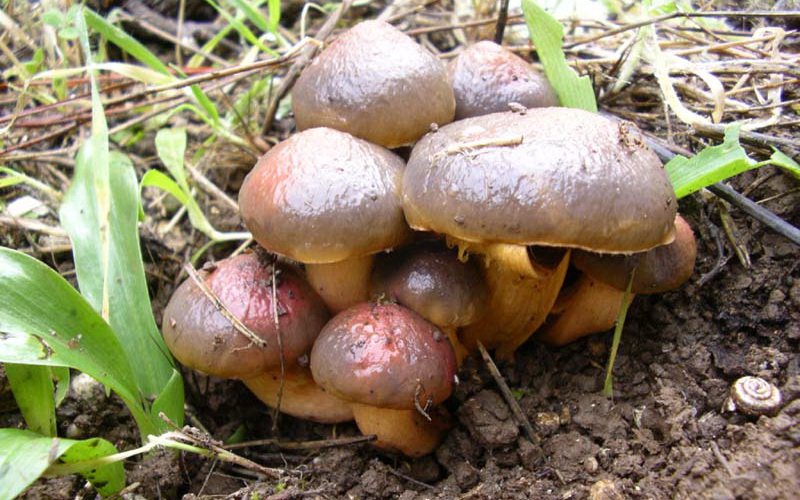
Edible mushroom: Purple loam (photo)
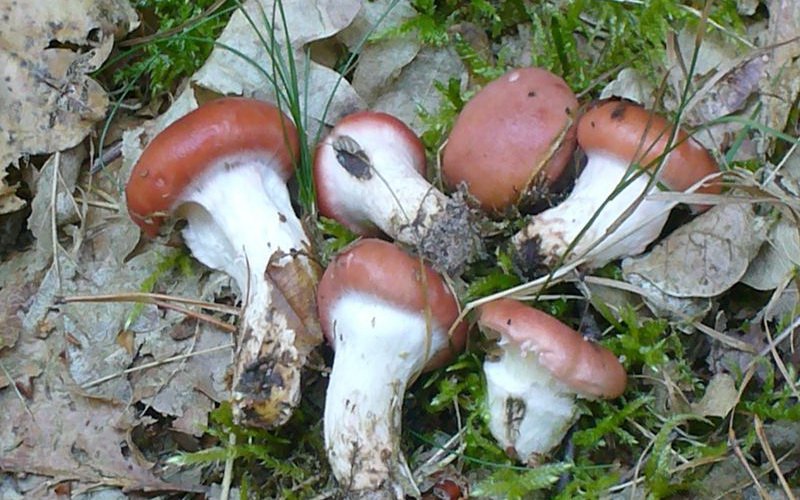
Edible mushroom: Mokruha pink (photo)

Edible mushroom: Spruce bark (photo)
Cooking use. Recipes
In Europe, spruce mokruha is considered a tasty product, and in China it is consumed more often than other mushrooms, in our country it is not very popular. Gummy moss can be salted, fried and pickled. It is also suitable for drying. Soups, sauces, casseroles, sandwiches are made from it. Spruce bark can be added to salads fried or boiled. It will give the dish a special taste and make it visually attractive.
It is preferred to be used as an addition to main dishes, mixed with other mushrooms.It goes well with meat or fish if fried or stewed with other more flavorful foods.
Before use, freshly picked moss are sorted out, damaged mushrooms are discarded. It is advised to remove all film and mucus. To do this, you need to cut the leg in half lengthwise to the very cap, then it will be very easy to remove the unnecessary skin.
Mushroom pickers recommend putting mushrooms in water for a few minutes before cleaning. Then the mucus layer will be removed even more easily. Fingers darken during cleaning, but after the procedure they are easily washed with soap and water. Then the mushrooms are washed and boiled for about 15-20 minutes. After heat treatment, the product darkens, this color change does not affect the taste of the product.
If the mushrooms are fried, then a lot of oil is not added, because the pulp will give juice, which is enough for further processing. For lovers of crispy and strong mushrooms after frying, mokruh is not suitable. It is not worth extinguishing sticky mokruh for too long, because the pulp will become tough.
How to pickle Mokrukha
Mushroom pickers advise marinating slugs along with other mushrooms. So, for 1 wet fur there are 8-10 boletus or cobwebs.
The following pickling recipe has proven itself well:
- The peeled mushrooms must be folded into a deep container and filled with water, adding a pinch of salt and the same amount of citric acid. The composition is brought to a boil and cooked for 15-20 minutes.
- The water is drained and the mushrooms are washed. They are now ready to marinate.
- 1 liter of water is poured into a saucepan and 80 g of sugar, 5 black peppercorns, 2 cloves, 50 g of salt, 100 ml of 6% vinegar and one laurel leaf are added.
- The resulting marinade is brought to a boil and 2 kg of prepared mushrooms are added to it. All are cooked together for 20 minutes.
- When the mushrooms sink to the bottom, and the water becomes clear, they are transferred together with the marinade into pre-prepared jars, pouring liquid so that it completely covers the moss with oily oils.
- Add 1 tablespoon of sunflower oil to each jar and close with nylon caps. Store pickled mushrooms in the refrigerator.
Below are other recipes with wet gummy:
Korean snack
Very fast and delicious.
To prepare this dish, you need to carefully separate the mushrooms from the film and boil. Then the mushrooms are fried along with chopped onions.
Korean carrots are added to the finished products, preferably not spicy. The dish is seasoned with olive oil.
Pepper stuffed with mushrooms and buckwheat
Most housewives are used to stuffing bell peppers with rice and meat. You can diversify the menu by replacing the filling with buckwheat and spruce mokrukh. To do this, you need to boil and fry the mushrooms a little. Then they should be mixed with raw buckwheat, salt and pepper to taste. The resulting composition is stuffed with peppers, which must be cleared of seeds in advance. Vegetables are stewed in water with the addition of tomato paste, or in fresh tomatoes.
Bachelor sandwiches
This is a very simple recipe that even a child can handle. It is necessary to fry a few slices of bread and spread a little butter on them. The peeled mushrooms are boiled and fried in a pan for 3-4 minutes. Fried mokruh is placed on the bread and sprinkled with grated cheese and herbs on top. Sandwiches need to be sent to the microwave for 1-2 minutes to melt the cheese.
Due to its low calorie content and a large amount of nutrients contained in this product, nutritionists recommend spruce moss for daily use. In terms of protein content, it can become a good competitor to meat dishes.
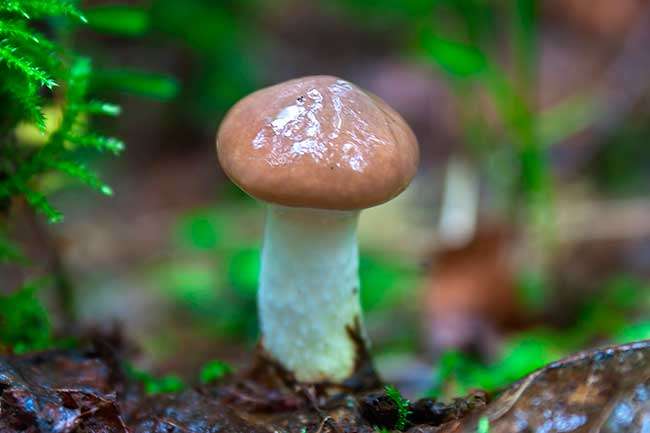
Collection rules
In order to avoid negative consequences, it is important to adhere to the basic rules for collecting mokruha:
The cut of the mushroom must be done in the middle of the leg, then cover the mycelium with needles.
It is strongly not recommended to collect moss near highways, military training grounds or chemical plants.
It is best to give preference to young specimens, since old mushrooms tend to accumulate toxic substances in themselves.
It is equally important to check the fruiting body for the absence of worminess.
Immediately after harvesting, it is important to heat-treat the wet mushrooms: at room temperature, the mushrooms quickly deteriorate.
Store in the refrigerator for up to 24 hours. At the same time, the fruit bodies should be kept in earthenware or enameled dishes.
Possible contraindications
Taking mokruha as food or additives to medicines and cosmetics does not cause complications. A purple shade of color helps not to confuse purple moss with any other poisonous mushroom. On the cut, this type of mushroom always takes on a pink or red color. However, even the seemingly harmless mushroom can have negative consequences on the human body. This can happen if the mushrooms were collected in a forest near highways, within a large city, near industrial enterprises or landfills. Such mushrooms should not be collected and eaten. For some people, mushroom food may be too heavy for their bodies to digest. These groups of people include children, the elderly and people suffering from diseases of the gastrointestinal tract. Chitin, which mushrooms contain, is practically not assimilated in an unprepared child's body.
spruce moss - description of where it grows, the toxicity of the mushroom
Cooking recipes
Spruce mokruha is more popular in Europe than in our region. This mushroom can not only be treated, but also salt, boil, fry, pickle, dry. Soups, second courses with the participation of this species are very tasty.
Primary processing
Before use, fresh mokruh is sorted out, damaged fruits are removed. Experienced lovers of quiet hunting are advised to process the mushroom, removing all the film and mucus. To do this, you need to cut the leg in half lengthwise to the very cap, then cleaning the slippery skin will be very easy.
Cooking
The boiling process is simple. The cleaned fruit bodies are placed in a container with boiling salted water and cooked for 15-20 minutes. If you plan to cook soup, then during cooking you need to constantly remove the resulting foam so that the broth does not darken. Be prepared for the broth to darken - this is typical for preparing mokruh dishes.
Pickling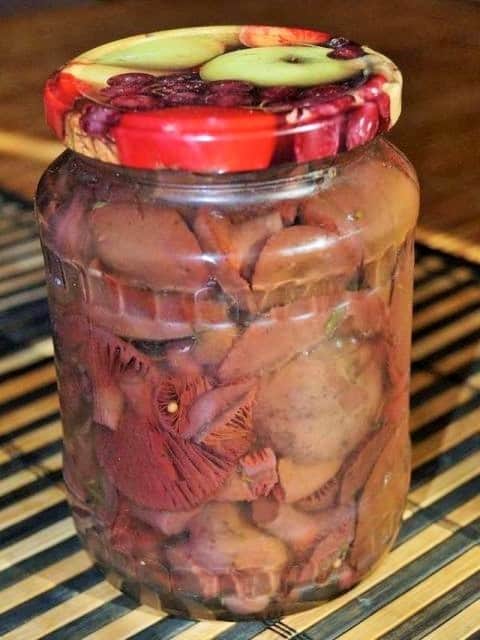
Housewives advise to pickle this type of mushroom in combination with other representatives of the forest, for example, boletus.
Ingredients:
- slug - 1-2 kg;
- water - 1 l;
- sugar - 80 g;
- salt - 50 g;
- vinegar - 100 ml;
- bay leaf, cloves, peppercorns - 2-3 pcs.
- citric acid - 1 pinch;
- vegetable oil - 1 tbsp. l. / 1 can.
Cooking method:
- Boil the mushrooms in a deep bowl with a pinch of salt and citric acid for 15 minutes.
- Drain the liquid, rinse the fruiting bodies.
- Prepare the marinade: put salt, sugar, spices in 1 liter of water, boil.
- Immerse mushrooms in hot brine, boil for 20 minutes.
- Once all the ingredients have settled to the bottom, you can distribute them to the jars.
- Arrange the mushrooms in sterilized, clean containers, fill with hot marinade so that it completely covers the contents.
- Pour in vegetable oil, cover with a plastic lid. Store these in the refrigerator or cellar.
Freezing
There is nothing difficult in this process. The mokruh boiled in salted water must be thoroughly dried, cut into small pieces, put in plastic containers or in special bags.
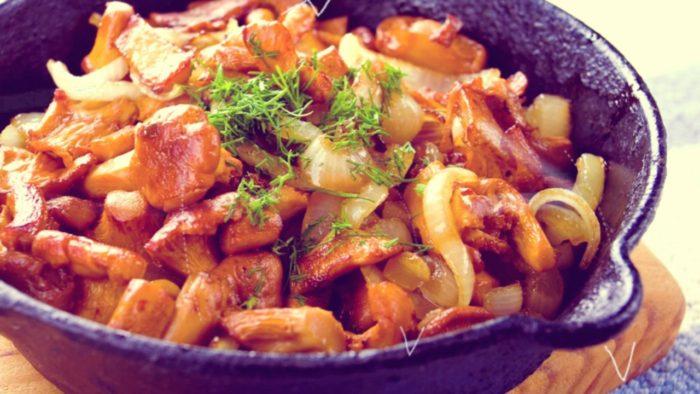 Frying
Frying
Mokruha spruce does not have a pronounced taste, it actively absorbs the juices of other products, therefore it is recommended to use it as part of other culinary dishes. Fried slugs are also quite tasty, they do not need to be boiled first.
Peel the moss and rinse thoroughly. Cut the fruit bodies into small pieces, place in a frying pan without oil.Cook with the lid closed until all the moisture is gone. Only then pour in the vegetable oil, put the onion cut into rings and fry for another 20-30 minutes.
Salting
Before salting this type of mushroom in a cold way, it does not need to be boiled. Cut the peeled fruit bodies into pieces, put in a container, sprinkle with salt. You can calculate its amount like this: 1 tbsp. a spoonful of salt per 1 kg of mushrooms. Put spices at the bottom of the container: currant and cherry leaves, dill umbrellas, clove buds, lavrushka. Layer everything, place oppression on top. After 2–4 days, if necessary, you can add brine so that it completely covers the product. After a month, the salting will be completely ready for use.
Drying
To keep slugs for a long time, you need to properly prepare them. First of all, it is necessary to remove spoiled, rotten specimens, inspect each fruit body.
Cut the fruit bodies into small pieces and place on a baking sheet. Send the tray to the oven (temperature should be within 50 ° C). It will take about 4 hours to dry the mushrooms. Check the readiness: the piece should be elastic, but not wet.
If you suddenly dry out the moss, it doesn't matter - turn them into powder, from which you can then make an ointment to treat joints.
Canning for the winter
Try making a delicious, flavorful canned mokruh snack. Guests and family will be delighted!
Ingredients:
- slugs - 2 kg;
- salt - 1/2 tbsp. l .;
- garlic - 10 cloves;
- vegetable oil.
Cooking method:
- Boil peeled moss in salted water. Do not forget to constantly skim off the foam during cooking.
- Place the fruit bodies in a colander, dry and cut into small slices.
- Place the mushrooms in a hot skillet (no oil) and cook until the water has completely evaporated.
- Add enough vegetable oil to completely cover the mushrooms. Cook for 40 minutes.
- Chop the garlic, mix it with salt.
- Add the salted garlic mass, stir and cook for another 20 minutes.
- Place the mushroom blank in sterilized jars, fill with hot oil.
- Roll up with metal lids, cool and only then store in a cool place.
False doubles
Purple moss has no resemblance to poisonous and inedible mushrooms. Similar species include:
-
spruce mokruha, which has a grayish tint of the cap and grows with spruce trees;
- pink has a surface of the corresponding color and light plates of the hymenophore;
- Swiss is painted in ocher color, its surface is felt;
-
spotted grows in deciduous forests and wears a gray-brown headdress;
-
felt has a corresponding pubescence on the cap.
Not very experienced mushroom pickers can confuse mokruha with a cobweb. Previously, it was attributed to this species.
How not to be confused with a cobweb?
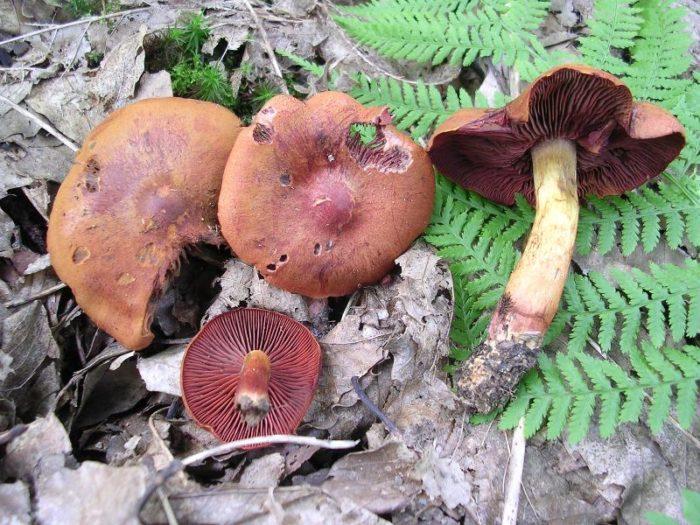 Cobweb purple
Cobweb purple
Often, it is with the purple spider web that inattentive lovers of quiet hunting are identified with the yellow-legged, but the most striking difference is the much lighter leg of the poisonous mushroom. And his hat has a reddish tint rather than purple. Although the spider web is considered poisonous, there have been no cases of poisoning.
Another important difference is the growth of the plates under the cap. In mokruha, they smoothly descend along the leg, and in all cobwebs they grow with a prong to it, with age they even rise up
Mokrukha purple and spruce
Purple mucosa (Gomphidius rutilus) is a rather rare lamellar mushroom, in some reference books referred to as mucous mucosa or glossy mucosa. It grows very abundantly in the self-seeding zones of pines (forms mycorrhiza with pine) in the forest and in the fields. It forms "witch circles" around single pines. Occurs from July to October.
The mushroom is edible.Glossy cap, slimy when wet, 3-12 cm in size, first conical with a blunt hump in the center, then convex, honey-brown or brown-orange, closer to autumn with a copper-purple tint.
The plates are rare, descending, first yellow-orange, then copper-purple and even blackish.
The stem is rounded, thinner at the base, about 7 cm high and about 2 cm in diameter. Its surface is longitudinally fibrous, moist, silky to the touch, the same color as the cap, but with a reddish tint at the base. Young mushrooms have a dark ring on the stem, which is absent in mature mushrooms.
The pulp is light, pink-yellowish, without a pronounced smell and taste. The spore powder is dark brown.
The appearance (a combination of the colors of the cap, plates and legs), as well as the presence of mucus that can desecrate the more noble varieties of mushrooms in the basket, most often force the mokruha to age at the place of its birth. Many collectors, when they meet a wet fur, can kick it with a foot or a stick.
It is impossible to confuse with other mushrooms.
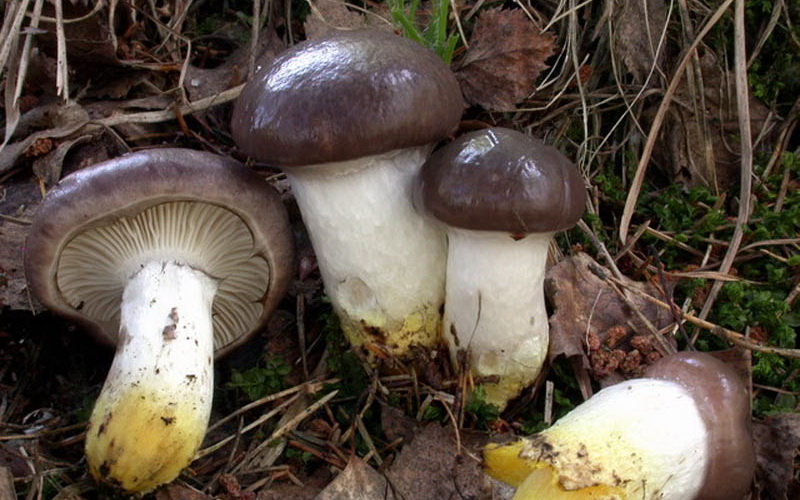
Spruce loam in the photo
Spruce peel is an edible lamellar mushroom that grows in small groups from mid-July until the first fall frost. The largest yields are in August-September. It is found mainly in bushes and on mossy soil areas in coniferous, especially spruce, forests, sometimes in mixed ones.
As you can see in the photo, the hat of the spruce moss is convex, but gradually it becomes prostrate, sometimes with a small depression in the middle:
Its diameter is about 11–13 cm. The surface of the cap is smooth, completely covered with a thick blanket of mucous membrane, painted in lilac or violet-brown color, on which there are sometimes small black spots. The plates are wide, descending, first white and then reddish-brown.
The leg is rounded, with a slight swelling in the center, which disappears over time. Solid inside. Its height is about 8 cm, and its diameter is about 1.5–2 cm. The surface of the leg is smooth, moist, white at the cap, bright yellow at the base. In the middle, the peduncle has a characteristic wide ring of tissue covered with mucus. The pulp is thick, firm, fleshy, tender, almost white, only at the base of the leg is yellowish, odorless.
Spruce peel belongs to the fourth category of mushrooms. It is eaten boiled, fried, salted and pickled. Before proceeding with the culinary processing of mushrooms, it is recommended to remove the mucous membrane covering it from the cap. Under the influence of high temperature, the flesh of the mushroom changes its color and becomes dark purple, almost black.




